Spatial Pattern and Coordination Relationship of Production–Living–Ecological Space Function and Residents’ Behavior Flow in Rural–Urban Fringe Areas
Abstract
1. Introduction
2. Materials and Methods
2.1. Study Area
2.2. Data Source and Processing
2.3. Methods
2.3.1. Behavior Flow Measurement of Residents
- Data standardization
- Indicator weighting
- Production–living–ecological behavior flow level
2.3.2. Evaluation of Production–Living–Ecological Space Functions
2.3.3. Behavior–Space Supply and Demand Matching Type and Coupling Coordination Relationship
3. Results
3.1. Behavior Flow Measurement of Residents
3.1.1. Behavior Flow Value Calculation
3.1.2. Behavior Flow Space Characteristics
3.2. Evaluation of Production–Living–Ecological Space Functions
3.2.1. PLES Membership Pattern
3.2.2. PLES Quality Evaluation
3.2.3. PLES Function Evaluation
3.3. Behavior-Space Supply and Demand Matching Type and Coupling Coordination Relationships
3.3.1. Behavior–Space Supply and Demand Matching Type
3.3.2. Behavior–Space Coupling Coordination Relationship
4. Discussion
4.1. Residents’ Behavior and PLES Function
4.2. Suggestions
4.3. Limitations
5. Conclusions
Author Contributions
Funding
Institutional Review Board Statement
Data Availability Statement
Conflicts of Interest
References
- Bai, X.A.; Shi, P.; Liu, Y. Society: Realizing China’s urban dream. Nature 2014, 509, 158–160. [Google Scholar] [CrossRef] [PubMed]
- Li, X.; Fang, B.; Yin, R.; Xu, X.; Chen, T.Y. Spatial pattern and association of production-living-ecological function and life quality on the village scale: A case of Yangzhong City, Jiangsu Province. Sci. Geogr. Sin. 2020, 40, 599–607. [Google Scholar] [CrossRef]
- DeFries, R.S.; Foley, J.A.; Asner, G.P. Land-use choices: Balancing human needs and ecosystem function. Front. Ecol. Environ. 2004, 2, 249–257. [Google Scholar] [CrossRef]
- Zhong, Y.; Li, L.; Qu, Y.; Xia, M. Research on the index allocation method of county urban construction land under the background of territorial space. In Proceedings of the 2022/2023 China Urban Planning Conference, Wuhan, China, 23–25 September 2023. [Google Scholar]
- Liu, Y. A Study on Spatial Optimization Strategy Based on the Characteristics of Rural Residents Production-Living-Ecological Behaviors—A Case Study of Lanzhou City. Master’s Thesis, Northwest Normal University, Lanzhou, China, 2019. [Google Scholar]
- Akkoyunlu, S. The Potential of Rural–Urban Linkages for Sustainable Development and Trade. Int. J. Sustain. Dev. World Policy 2015, 4, 20–40. [Google Scholar] [CrossRef]
- Xu, B.; Fu, B. Conceptual evolution and classification system reconstruction of urban fringe. Arid Land Geogr. 2023, 46, 1903–1914. [Google Scholar]
- Duan, Y.; Wang, H.; Huang, A.; Xu, Y.; Lu, L.; Ji, Z. Identification and spatial-temporal evolution of rural “production-living-ecological” space from the perspective of villagers’ behavior—A case study of Ertai Town, Zhangjiakou City. Land Use Policy 2021, 106, 105457. [Google Scholar] [CrossRef]
- Wang, D.; Jiang, D.; Fu, J.; Lin, G.; Zhang, J. Comprehensive Assessment of Production-Living-Ecological Space Based on the Coupling Coordination Degree Model. Sustainability 2020, 12, 2009. [Google Scholar] [CrossRef]
- Cui, X.; Xu, N.; Chen, W.; Wang, G.; Liang, J.; Pan, S.; Duan, B. Spatio-Temporal Variation and Influencing Factors of the Coupling Coordination Degree of Production-Living-Ecological Space in China. Int. J. Environ. Res. Public Health 2022, 19, 10370. [Google Scholar] [CrossRef] [PubMed]
- Willemen, L.; Hein, L.; van Mensvoort, M.E.F.; Verburg, P.H. Space for people, plants, and livestock? Quantifying interactions among multiple landscape functions in a Dutch rural region. Ecol. Indic. Landsc. Assess. Sustain. Plan. 2010, 10, 62–73. [Google Scholar] [CrossRef]
- Liu, D.; Ma, X.; Gong, J.; Li, H. Functional identification and spatiotemporal pattern analysis of production-living-ecological space in watershed scale: A case study of Bailongjiang Watershed in Gansu. Chin. J. Ecol. 2018, 37, 1490–1497. [Google Scholar] [CrossRef]
- Xie, X.T.; Li, X.S. Spatio-temporal evolution characteristics and influencing factors of “production-living-ecological” functions in Henan Province, China. Trans. Chin. Soc. Agric. Eng. 2021, 37, 243–252. [Google Scholar]
- Pan, F.; Shu, N.; Wan, Q.; Huang, Q. Land Use Function Transition and Associated Ecosystem Service Value Effects Based on Production-Living-Ecological Space: A Case Study in the Three Gorges Reservoir Area. Land 2023, 12, 391. [Google Scholar] [CrossRef]
- Xie, X.; Li, X.; Fan, H.; He, W. Spatial analysis of production-living-ecological functions and zoning method under symbiosis theory of Henan, China. Environ. Sci. Pollut. Res. 2021, 28, 6909–69110. [Google Scholar] [CrossRef]
- Jin, G.; Deng, X.; Zhang, Q.; Wang, Z.Q.; Li, Z.H. Comprehensive function zoning of national land space for Wuhan metropolitan region. Geogr. Res. 2017, 36, 541–552. [Google Scholar]
- Cheng, T.; Zhao, R.; Liang, Y. Production-living-ecological Space Classification and Its Functional Evaluation. Remote Sens. Inf. 2018, 33, 114–121. [Google Scholar]
- Fu, J.; Zhang, S. Functional Assessment and Coordination Characteristics of Production, Living, Ecological Function—A Case Study of Henan Province, China. Int. J. Environ. Res. Public Health 2021, 18, 8051. [Google Scholar] [CrossRef]
- Wang, C.; Tang, N. Spatio-temporal characteristics and evolution of rural production-living-ecological space function coupling coordination in Chongqing Municipality. Geogr. Res. 2018, 37, 1100–1114. [Google Scholar]
- Li, X.; Fang, B.; Yin, R.; Rong, H. Spatial-temporal change and collaboration/trade-off relationship of "production-living-ecological" functions in county area of Jiangsu province. J. Nat. Resour. 2019, 34, 2363–2377. [Google Scholar]
- Zhao, J.; Zhao, Y. Synergy/trade-offs and differential optimization of production, living, and ecological functions in the Yangtze River economic Belt, China. Ecol. Indic. 2023, 147, 109925. [Google Scholar] [CrossRef]
- Li, G.; Fang, C. Quantitative function identification and analysis of urban ecological-production-living spaces. Acta Geogr. Sin. 2016, 71, 49–65. [Google Scholar]
- Duan, Y.; Xu, Y.; Huang, A.; Lu, L.; Ji, Z. Progress and prospects of “production-living ecological” functions evaluation. J. China Agric. Univ. 2021, 26, 113–124. [Google Scholar]
- Zhang, Z.; Hou, Y.; Sun, H.; Guo, S. Study on the evaluation of the spatial function and coordination relationship of the territorial “production-living-ecological” spaces at the township-street scale. J. Nat. Resour. 2022, 37, 2898–2914. [Google Scholar] [CrossRef]
- Liu, C.; Wang, Y.; He, R.; Wang, C. An analysis framework for identifying and optimizing ecological-production-living space based on resident behavior. J. Nat. Resour. 2019, 34, 2113–2122. [Google Scholar] [CrossRef]
- Zhao, Q.; Jiang, G.; Yang, Y.; Tian, Y.; Fan, L.; Zhou, T.; Tian, Y. Multifunction change of rural housing land in metropolitan suburbs from the perspective of farmer households’ land-use behavior. Land Use Policy 2022, 119, 106206. [Google Scholar] [CrossRef]
- Carter, I. Human Behavior in the Social Environment: A Social Systems Approach, 6th ed.; Routledge: New York, NY, USA, 2017. [Google Scholar] [CrossRef]
- Tianjin Government Affairs. 2021; Location of Tianjin. Available online: https://www.tj.gov.cn/sq/tjgk/zrdl/dlwz/ (accessed on 14 December 2023).
- Xu, X.; Liu, J.; Zhang, S.; Li, R.; Yan, C.; Wu, S. Remote Sensing Data Set of Multi-Period Land Use Monitoring in China (CNLUCC). Data Registration and Publishing System of Data Center of Resources and Environmental Sciences; Chinese Academy of Sciences: Beijing, China, 2018. [Google Scholar] [CrossRef]
- Gorgij, A.D.; Kisi, O.; Moghaddam, A.A.; Taghipour, A. Groundwater quality ranking for drinking purposes, using the entropy method and the spatial autocorrelation index. Environ. Earth Sci. 2017, 76, 269. [Google Scholar] [CrossRef]
- Liu, Y.; Liu, Y.; Chen, Y. Territorial Multi-functionality Evaluation and Decision-making Mechanism at County Scale in China. Acta Geogr. Sin. 2011, 66, 1379–1389. [Google Scholar]
- Liu, J.L.; Liu, Y.; Li, Y. Classification evaluation and spatial-temporal analysis of “production-living-ecological” spaces in China. Acta Geogr. Sin. 2017, 72, 1290–1304. [Google Scholar]
- Liu, P.; Sun, B. The spatial pattern of urban production-living-ecological space quality and its related factors in China. Geogr. Res. 2020, 39, 13–24. [Google Scholar]
- Lovie, P. Coefficient of Variation. In Encyclopedia of Statistics in Behavioral Science; John Wiley & Sons, Ltd.: Hoboken, NJ, USA, 2005. [Google Scholar] [CrossRef]
- Wang, M.; Wang, Y.C. Measurement and Optimization of Supply and Demand of Park Green Space at Urban Block Scale: A Case Study of Yangpu District, Shanghai. Landsc. Archit. 2021, 28, 22–27. [Google Scholar] [CrossRef]
- Lin, G.; Fu, J.; Jiang, D. Production–Living–Ecological Conflict Identification Using a Multiscale Integration Model Based on Spatial Suitability Analysis and Sustainable Development Evaluation: A Case Study of Ningbo, China. Land 2021, 10, 383. [Google Scholar] [CrossRef]
- Tian, J.; Wang, B.; Wang, S. Urban Land Use Efficiency and Its Coupling Relationship in the Three Provinces of Northeast China. Sci. Geogr. Sin. 2019, 39, 305–315. [Google Scholar] [CrossRef]
- Zhang, L.; Hou, Q.; Duan, Y. A literature review on Production-Living-Ecological Spaces in the context of ecological civilization: Connotation, problems and countermeasures. Acta Ecol. Sin. 2024, 44, 47–59. [Google Scholar] [CrossRef]
- Fan, Y.; Khattak, A.J. Urban Form, Individual Spatial Footprints, and Travel: Examination of Space-Use Behavior. Transp. Res. Rec. 2008, 2082, 98–106. [Google Scholar] [CrossRef]
- Næss, P. Residential location affects travel behavior—But how and why? The case of Copenhagen metropolitan area. Prog. Plan. 2005, 63, 167–257. [Google Scholar] [CrossRef]
- Silva, J.D.A.E.; Golob, T.F.; Goulias, K.G. Effects of Land Use Characteristics on Residence and Employment Location and Travel Behavior of Urban Adult Workers. Transp. Res. Rec. 2006, 1977, 121–131. [Google Scholar] [CrossRef]
- Lee, J.H.; Davis, A.W.; Goulias, K.G. Triggers of behavioral change: Longitudinal analysis of travel behavior, household composition and spatial characteristics of the residence. J. Choice Model. 2017, 24, 4–21. [Google Scholar] [CrossRef]
- Kim, J.Y.; Kim, Y.O. Residents’ Spatial-Usage Behavior and Interaction According to the Spatial Configuration of a Social Housing Complex: A Comparison between High-Rise Apartments and Perimeter Block Housing. Sustainability 2022, 14, 1138. [Google Scholar] [CrossRef]
- De Vos, J.; Cheng, L.; Witlox, F. Do changes in the residential location lead to changes in travel attitudes? A structural equation modeling approach. Transportation 2021, 48, 2011–2034. [Google Scholar] [CrossRef]
- Klinger, T.; Lanzendorf, M. Moving between mobility cultures: What affects the travel behavior of new residents? Transportation 2016, 43, 243–271. [Google Scholar] [CrossRef]
- Jarass, J.; Scheiner, J. Residential self-selection and travel mode use in a new inner-city development neighbourhood in Berlin. J. Transp. Geogr. 2018, 70, 68–77. [Google Scholar] [CrossRef]
- Tsoulou, I.; Andrews, C.J.; He, R.; Mainelis, G.; Senick, J. Summertime thermal conditions and senior resident behaviors in public housing: A case study in Elizabeth, NJ, USA. Build. Environ. 2020, 168, 106411. [Google Scholar] [CrossRef]
- Gür, M. Post-pandemic lifestyle changes and their interaction with resident behavior in housing and neighborhoods: Bursa, Turkey. J. Hous. Built Environ. 2022, 37, 823–862. [Google Scholar] [CrossRef] [PubMed]
- Yamazaki, T.; Iida, A.; Hino, K.; Murayama, A.; Hiroi, U.; Terada, T.; Koizumi, H.; Yokohari, M. Use of Urban Green Spaces in the Context of Lifestyle Changes during the COVID-19 Pandemic in Tokyo. Sustainability 2021, 13, 9817. [Google Scholar] [CrossRef]
- Wang, H.T.; Ma, S.; Wan, T.; Guo, B.F.; Zhao, S.M. Assessment of road traffic carbon emission reduction in urban development area: A case study of Xiqing District, Tianjin. Presented at the Resilient Transport: Quality and Service—China Urban Transport Planning Annual Conference 2023, Xi’an China, 12–13 October 2023; p. 23.
- Golledge, R.G. Spatial Behavior: A Geographic Perspective; Guilford Press, New York, NY, USA, 1997.
- Fang, F.; He, R. Study on the characteristics and mechanism of spatial evolution of rural three-life from the perspective of peasant household behavior. Study Pract. 2018, 1, 101–110. [Google Scholar] [CrossRef]
- Sun, S. The Types and Structure of Knowledge in Territorial Spatial Planning. Urban Plan. Forum 2020, 1, 11–18. [Google Scholar]
- Zhang, Y.; Deng, W.T.; Zhao, L.Z. Evaluation of urban construction land use efficiency and optimization strategy of land allocation: Based on the empirical study on 2165 municipal districts, county-level cities, and counties in China. City Plan. Rev. 2023, 1–8. Available online: http://kns.cnki.net/kcms/detail/11.2378.tu.20230525.1712.004.html (accessed on 4 December 2023).
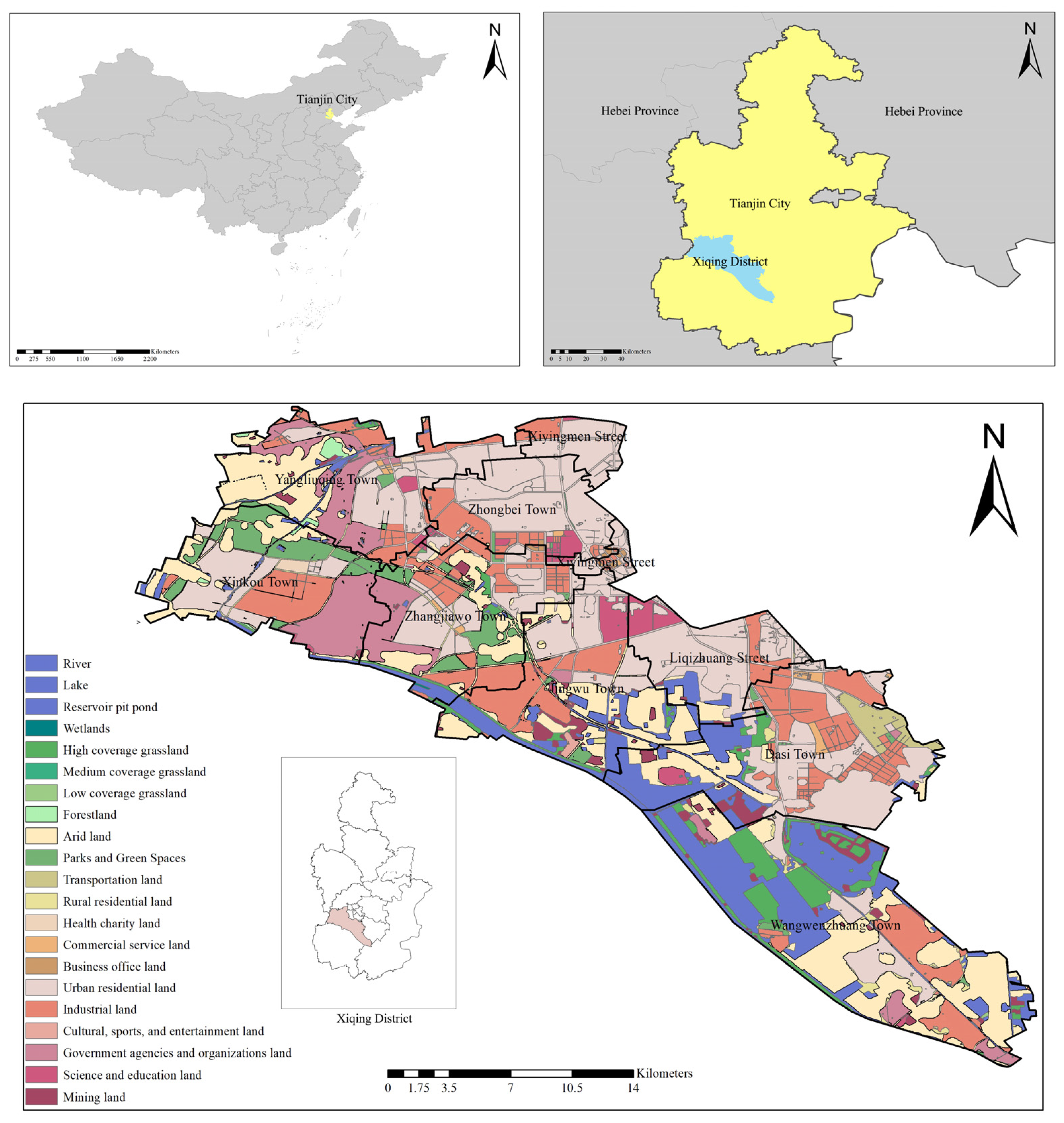

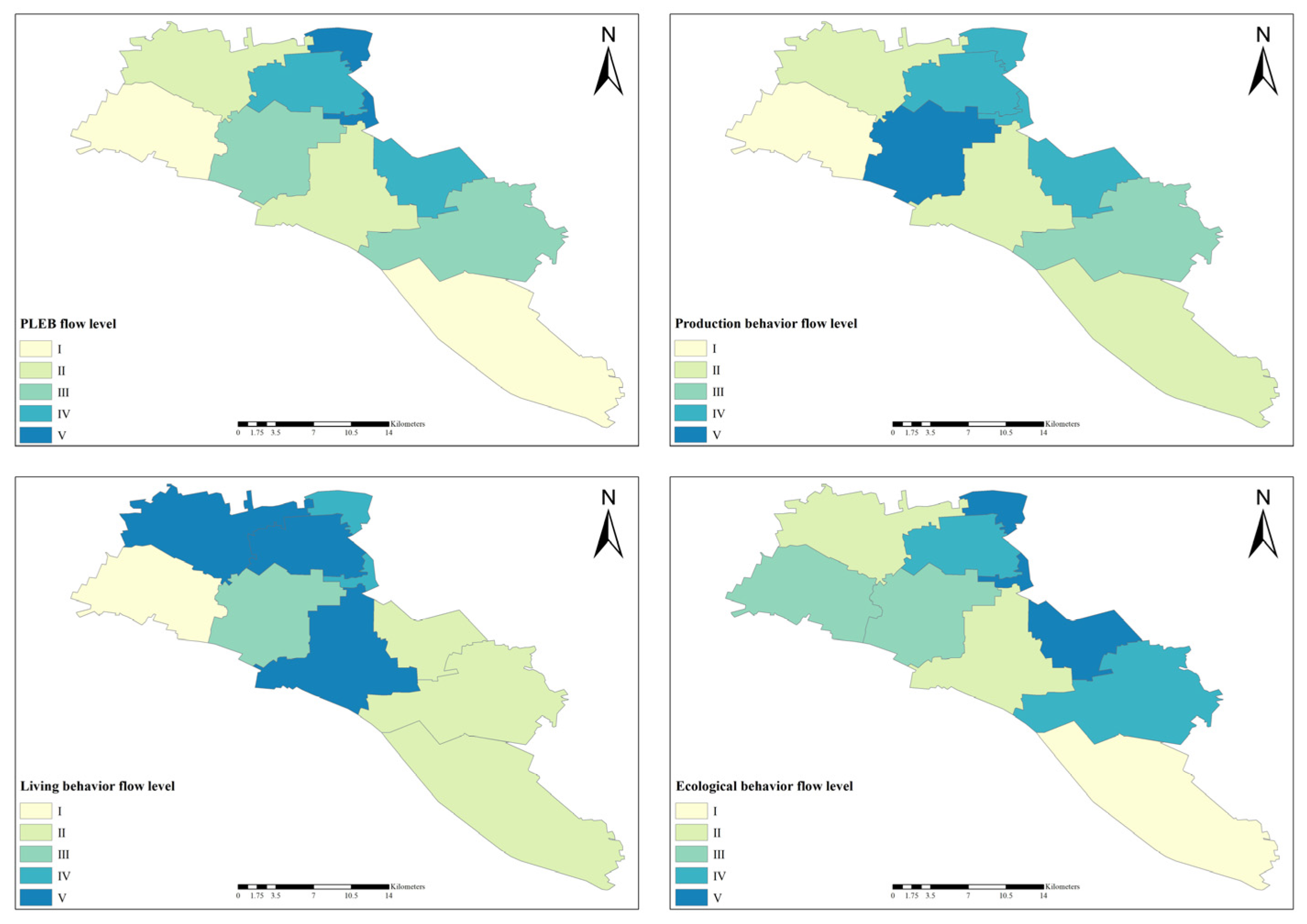


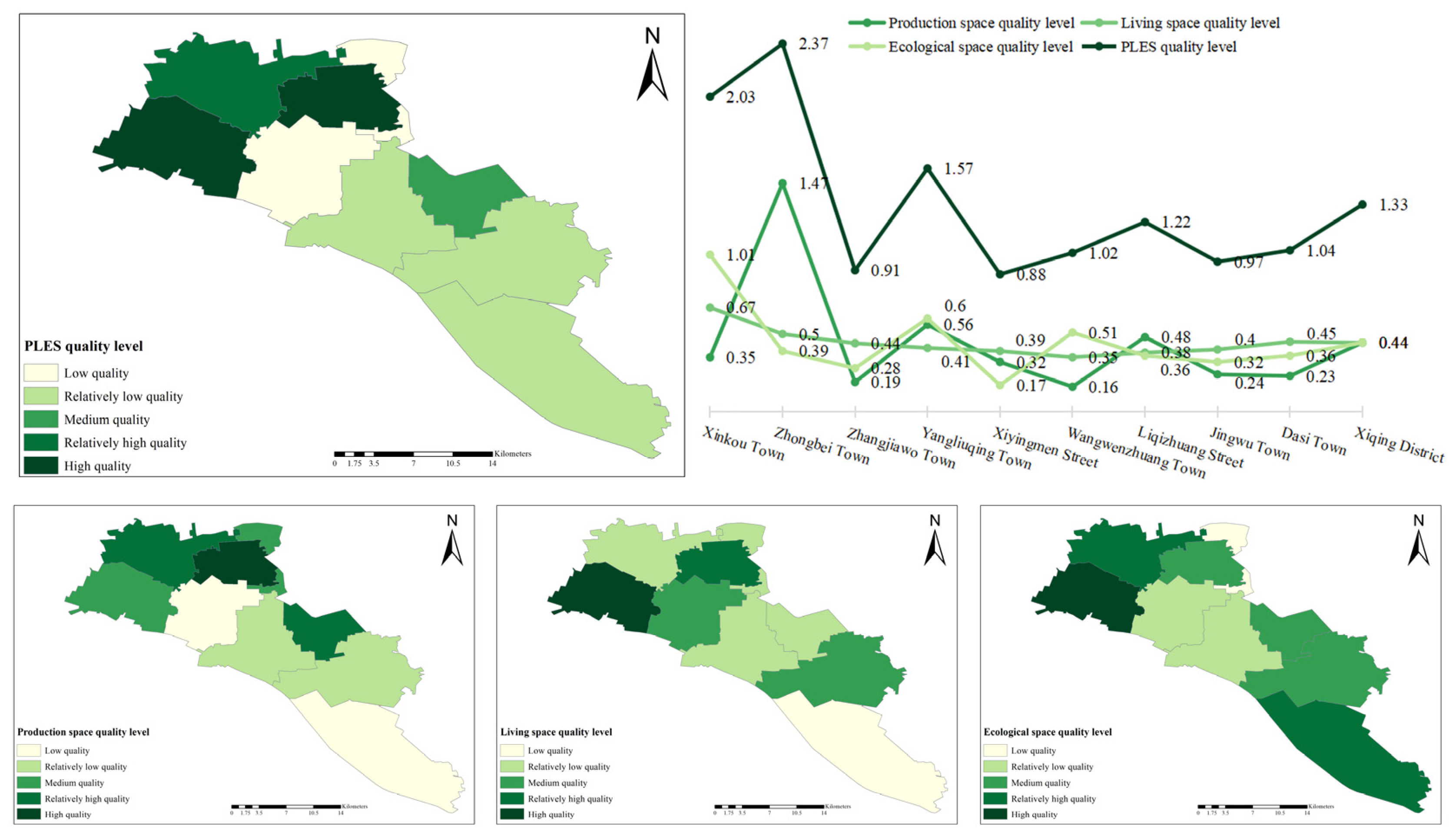
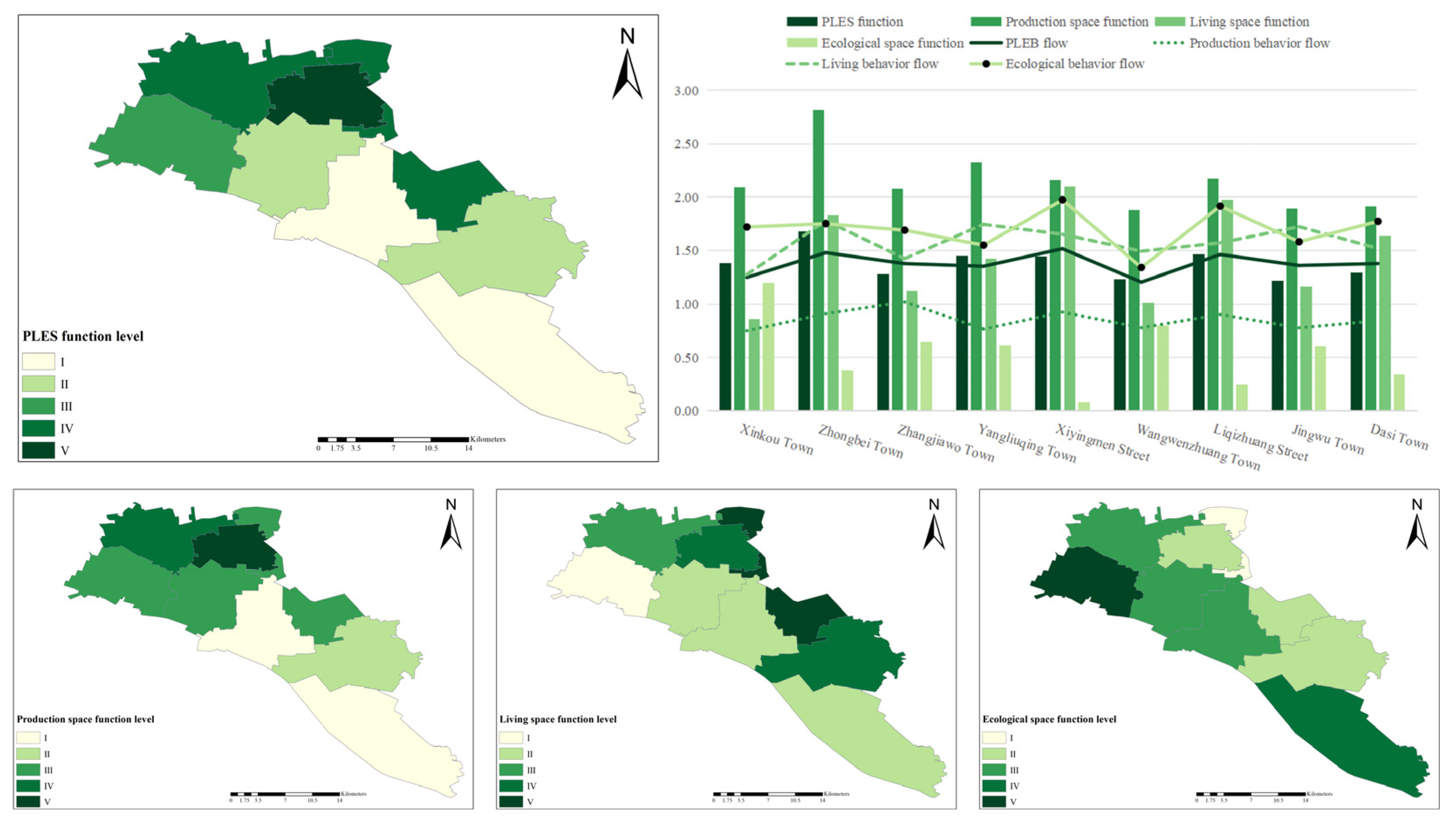
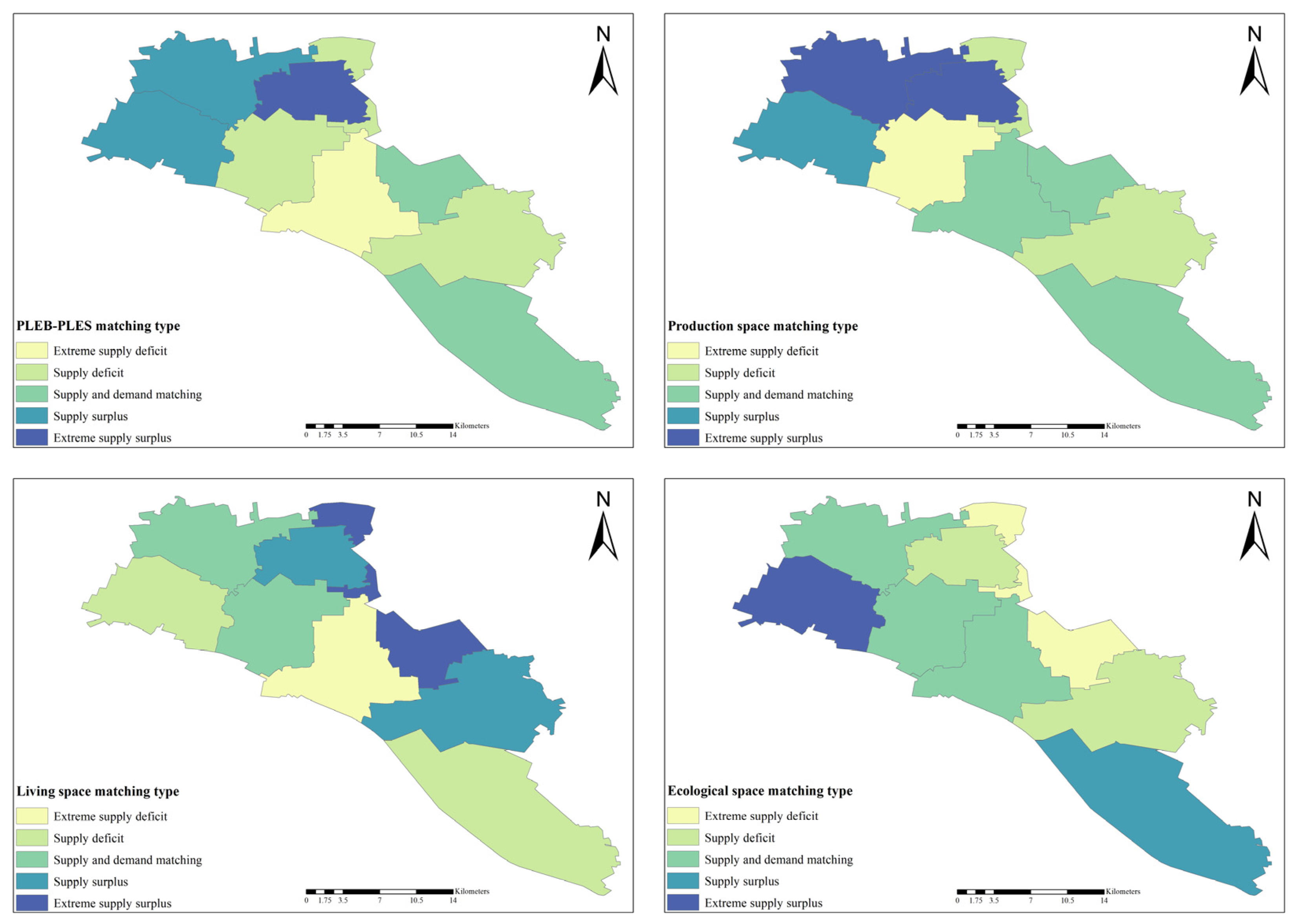
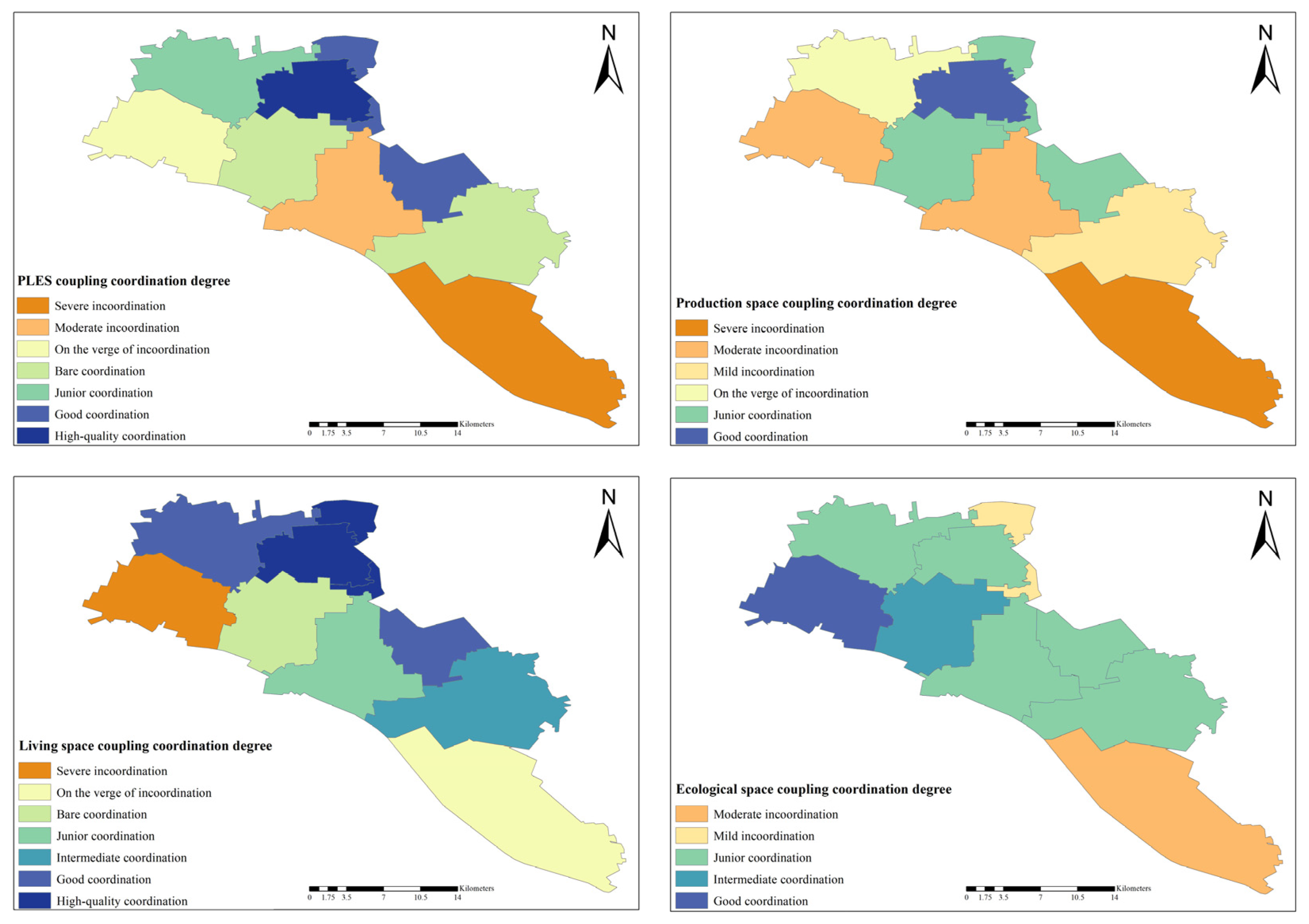
| First Level Indicators | Secondary Indicators | Indicator Quantification Layer | Assignment | Weight |
|---|---|---|---|---|
| Production behavior flow | Production behavior flow distance | In and around the village/community | 1 | 12.35% |
| Within the town/street | 2 | |||
| Other towns/streets in Xiqing District | 3 | |||
| Outside Xiqing District | 4 | |||
| Outside Tianjin | 5 | |||
| Production behavior flow mode | On foot | 1 | 7.90% | |
| Non-motor vehicle | 2 | |||
| Motorcycle | 3 | |||
| Public transport | 4 | |||
| Private car | 5 | |||
| Production behavior flow frequency | Once every six months | 1 | 0.42% | |
| Once in three months | 2 | |||
| Once a month | 3 | |||
| Once every half month | 4 | |||
| Multiple times a week | 5 | |||
| Life behavior flow | Life behavior flow distance | In and around the village/community | 1 | 22.99% |
| Within the town/street | 2 | |||
| Other towns/streets in Xiqing District | 3 | |||
| Outside Xiqing District | 4 | |||
| Outside Tianjin | 5 | |||
| Life behavior flow mode | On foot | 1 | 16.21% | |
| Non-motor vehicle | 2 | |||
| Motorcycle | 3 | |||
| Public transport | 4 | |||
| Private car | 5 | |||
| Life behavior flow frequency | Once every six months | 1 | 2.88% | |
| Once in three months | 2 | |||
| Once a month | 3 | |||
| Once every half month | 4 | |||
| Multiple times a week | 5 | |||
| Ecological behavior flow | Ecological behavior flow distance | In and around the village/community | 1 | 13.30% |
| Within the town/street | 2 | |||
| Other towns/streets in Xiqing District | 3 | |||
| Outside Xiqing District | 4 | |||
| Outside Tianjin | 5 | |||
| Ecological behavior flow mode | On foot | 1 | 13.65% | |
| Non-motor vehicle | 2 | |||
| Motorcycle | 3 | |||
| Public transport | 4 | |||
| Private car | 5 | |||
| Ecological behavior flow frequency | Once every six months | 1 | 10.30% | |
| Once in three months | 2 | |||
| Once a month | 3 | |||
| Once every half month | 4 | |||
| Multiple times a week | 5 |
| Primary Classification | Secondary Classification | Space Membership Value | ||||
|---|---|---|---|---|---|---|
| Code | Land use type | Code | Land use type | Production space | Living space | Ecological space |
| 1 | Arable land | 13 | Arid land | 3 | 0 | 3 |
| 3 | Forestland | 31 | Forestland | 0 | 0 | 5 |
| 4 | Grassland | 41 | High coverage grassland | 0 | 0 | 5 |
| 42 | Medium coverage grassland | 0 | 0 | 5 | ||
| 43 | Low coverage grassland | 0 | 0 | 5 | ||
| 5 | Commercial land | 51 | Commercial service land | 5 | 1 | 0 |
| 52 | Business office land | 5 | 1 | 0 | ||
| 6 | Industrial and mining storage land | 61 | Industrial land | 5 | 1 | 0 |
| 62 | Mining land | 5 | 1 | 0 | ||
| 7 | Residential land | 71 | Urban residential land | 3 | 5 | 0 |
| 72 | Rural residential land | 3 | 5 | 0 | ||
| 8 | Public management and public service land | 81 | Government agencies and organizations land | 3 | 3 | 0 |
| 83 | Science and education land | 3 | 3 | 0 | ||
| 84 | Health charity land | 3 | 3 | 0 | ||
| 85 | Cultural, sports, and entertainment land | 3 | 3 | 0 | ||
| 87 | Parks and green spaces | 1 | 3 | 1 | ||
| 10 | Transportation land | 5 | 0 | 0 | ||
| 11 | Water areas and water conservancy facility land | 111 | River | 0 | 0 | 5 |
| 112 | Lake | 0 | 0 | 5 | ||
| 113 | Reservoir pit pond | 1 | 0 | 1 | ||
| 12 | Other land | 125 | Wetlands | 0 | 0 | 5 |
| First-Level Indicators | Second-Level Indicators | Specific Index Calculation Methods (Unit) | Index Property |
|---|---|---|---|
| Production space quality index (PQI) | Input index | Number of employees in secondary and tertiary industries per unit of construction land (Person/km2) | + |
| Investment in fixed assets per unit of construction land (100 million yuan/km2) | + | ||
| Population density per unit of construction land (Person/km2) | + | ||
| Output index | Gross industrial output value per unit of construction land (10,000 yuan/km2) | + | |
| Tertiary industry operating income per unit of construction land (10,000 yuan/km2) | + | ||
| Primary production value added per unit of cultivated land area (100 million yuan/km2) | + | ||
| Tax completion status per unit of construction land (10,000 yuan/km2) | + | ||
| Total power of agricultural machinery per unit cultivated land area (kW/km2) | + | ||
| Living space quality index (LQI) | Comfort index | Disposable income of residents (yuan) | + |
| GDP per capita (yuan) | + | ||
| Per capita disposable income as a share of per capita GDP (%) | + | ||
| Convenience index | Road network density (km/km2) | + | |
| Number of park squares per 10,000 people | + | ||
| Number of schools per 10,000 people | + | ||
| Number of hospitals and health stations per 10,000 people | + | ||
| Number of cultural and sport activity centers per 10,000 people | + | ||
| Ecological space quality index (EQI) | Green development | Green coverage rate (%) | + |
| Per capita green space area (m2/person) | + | ||
| Ecological land area (km2) | + | ||
| Proportion of ecological land area to total land area (%) | + | ||
| Environmental protection | Land area for construction of domestic waste transfer station (m2) | + | |
| Scale of domestic waste transfer station (tons/day) | + | ||
| Agricultural chemical fertilizer usage per unit cultivated land area (tons/km2) | - | ||
| Effective irrigation area (km2) | - |
| Space Membership | Space Quality | ||
|---|---|---|---|
| Index | Weight | Index | Weight |
| Production space membership | = 21.14% | Production space quality | = 19.25% |
| Living space membership | = 13.36% | Living space quality | = 16.84% |
| Ecological space membership | = 13.36% | Ecological space quality | = 16.04% |
| Type/Degree | Division Basis | |
|---|---|---|
| Supply–demand matching type | Extreme supply deficit | Natural breakpoint method |
| Supply deficit | ||
| Supply and demand matching | ||
| Supply surplus | ||
| Extreme supply surplus | ||
| Coupling coordination degree | Extreme incoordination | D ∈ (0.0~0.1) |
| Severe incoordination | D ∈ [0.1~0.2) | |
| Moderate incoordination | D ∈ [0.2~0.3) | |
| Mild incoordination | D ∈ [0.3~0.4) | |
| On the verge of incoordination | D ∈ [0.4~0.5) | |
| Bare coordination | D ∈ [0.5~0.6) | |
| Junior coordination | D ∈ [0.6~0.7) | |
| Intermediate coordination | D ∈ [0.7~0.8) | |
| Good coordination | D ∈ [0.8~0.9) | |
| High-quality coordination | D ∈ [0.9~1.0) |
| Production Behavior Flow | Life Behavior Flow | Ecological Behavior Flow | PLEB Flow | |
|---|---|---|---|---|
| Xiqing District | 0.852 | 1.577 | 1.701 | 1.377 |
| Xiyingmen Street | 0.924 | 1.653 | 1.975 | 1.249 |
| Liqizhuang Street | 0.902 | 1.573 | 1.916 | 1.480 |
| Zhongbei Town | 0.910 | 1.780 | 1.752 | 1.379 |
| Yangliuqing Town | 0.765 | 1.746 | 1.551 | 1.354 |
| Xinkou Town | 0.749 | 1.277 | 1.721 | 1.517 |
| Zhangjiawo Town | 1.020 | 1.425 | 1.691 | 1.204 |
| Jingwu Town | 0.777 | 1.724 | 1.583 | 1.464 |
| Dasi Town | 0.844 | 1.520 | 1.774 | 1.361 |
| Wangwenzhuang Town | 0.778 | 1.494 | 1.342 | 1.379 |
Disclaimer/Publisher’s Note: The statements, opinions and data contained in all publications are solely those of the individual author(s) and contributor(s) and not of MDPI and/or the editor(s). MDPI and/or the editor(s) disclaim responsibility for any injury to people or property resulting from any ideas, methods, instructions or products referred to in the content. |
© 2024 by the authors. Licensee MDPI, Basel, Switzerland. This article is an open access article distributed under the terms and conditions of the Creative Commons Attribution (CC BY) license (https://creativecommons.org/licenses/by/4.0/).
Share and Cite
Sun, X.; Zhang, B.; Ye, S.; Grigoryan, S.; Zhang, Y.; Hu, Y. Spatial Pattern and Coordination Relationship of Production–Living–Ecological Space Function and Residents’ Behavior Flow in Rural–Urban Fringe Areas. Land 2024, 13, 446. https://doi.org/10.3390/land13040446
Sun X, Zhang B, Ye S, Grigoryan S, Zhang Y, Hu Y. Spatial Pattern and Coordination Relationship of Production–Living–Ecological Space Function and Residents’ Behavior Flow in Rural–Urban Fringe Areas. Land. 2024; 13(4):446. https://doi.org/10.3390/land13040446
Chicago/Turabian StyleSun, Xiaochen, Bingzi Zhang, Shuni Ye, Sara Grigoryan, Yazhuo Zhang, and Yike Hu. 2024. "Spatial Pattern and Coordination Relationship of Production–Living–Ecological Space Function and Residents’ Behavior Flow in Rural–Urban Fringe Areas" Land 13, no. 4: 446. https://doi.org/10.3390/land13040446
APA StyleSun, X., Zhang, B., Ye, S., Grigoryan, S., Zhang, Y., & Hu, Y. (2024). Spatial Pattern and Coordination Relationship of Production–Living–Ecological Space Function and Residents’ Behavior Flow in Rural–Urban Fringe Areas. Land, 13(4), 446. https://doi.org/10.3390/land13040446







